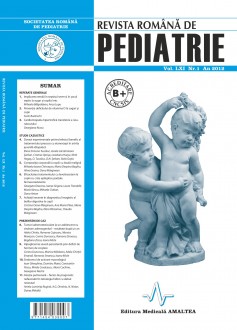SELECT ISSUE

Indexed

| |

|
|
|
| |
|
|
|

|
|
|
|
|
|
|
HIGHLIGHTS
National Awards “Science and Research”
NEW! RJP has announced the annually National Award for "Science and Research" for the best scientific articles published throughout the year in the official journal.
Read the Recommendations for the Conduct, Reporting, Editing, and Publication of Scholarly work in Medical Journals.
The published medical research literature is a global public good. Medical journal editors have a social responsibility to promote global health by publishing, whenever possible, research that furthers health worldwide.
Body composition of children with malignant disease
Mihaela Ioana Chinceşan, Maria Despina Baghiu, Alina Grama and Oana Marginean
ABSTRACT
Background. Nutritional status, as represented by body composition, is an important considerant in the treatment of pediatric cancer patients because it is linked to poor outcomes.
Objective. We aimed to compare nutritional status with children with malignant disease at diagnosis as compared to children with nononcological disease.
Material and method: A prospective study was performed on 90 children hospitalised in the Pediatric Clinic I Tg. Mures, between November 2009 - July 2011. The children were divided into two groups: group 1, children with malignant disease (35 children) and group 2-control group, children with different pediatric diseases (55 children). We have done anthropometric and biochemical measuremeants: weight, height, body mass index, middle upper arm circumference, tricipital skin fold thickness, total serum protein and albumin, Insulin-like growth factor-1, total cholesterol, tryglicerides and sideremy. We studied the anthropometric and biochemical parameters compared to the two groups and performed statistical correlations.
Results. The weight and height of children in group I was much lower compared with group II, without statistically significant difference (p>0.05). We also found a statistically significant difference among the anthropometric parameters of the arm: middle upper arm circumference – MUAC (-1.58 DS versus -0.74 DS ) with p = 0.022 and tricipital skin fold thickness – TSF (-1.34 DS versus -0.74 DS) with p = 0.05. Regarding biochemical parameters, between the two groups, we observed a significant difference(p<0.05) with the total serum protein and albumin, IGF-1, sideremy and tryglicerides.
Conclusions. This study showed that the children’s group diagnosed with cancer has a poor nutritional status than the control group; the anthropometric parameters of the arm in conjunction with biochemical parameters best reflects the body composition.
Key words: child, malignant disease, anthropometric parameters, biochemical parameters
